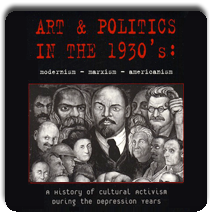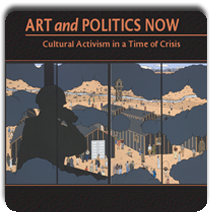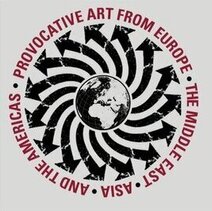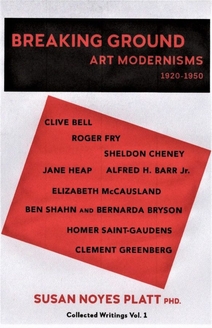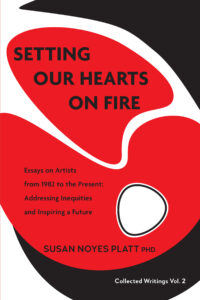Jaune Quick-to-See Smith and Joy Harjo in Seattle
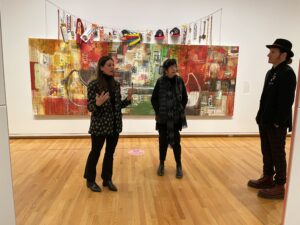
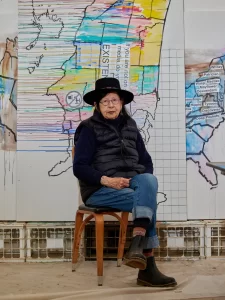
Jaune Quick To See Smith (center)and her Son Neal Ambrose-Smith with Whitney Curator Laura Phipps at “Memory Map,” exhibition in Seattle Art Museum, in front of Gifts for Trading Lands With White People
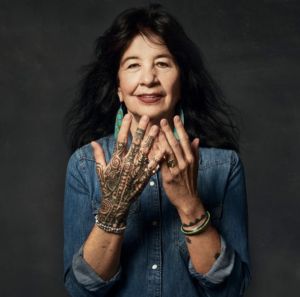 Jo Harjo reading her poem “Running” from her book An American Sunrise
Jo Harjo reading her poem “Running” from her book An American Sunrise
https://www.youtube.com/watch?v=Y8vwqWJsJiI
During one amazing week in March in Seattle Jaune Quick-to-See Smith (citizen of the Confederated Salish and Kootenai Nation) and Joy Harjo ( Mvskoke Nation) were both in Seattle. Jaune was here to open her one person exhibition at the Seattle Art Museum and Joy Harjo did a reading at our local “Town Hall” a cultural center.
Above you see Jaune and her son Neil with whom she collaborates, at the opening ,in front of Gifts for Trading Land with White People
Joy did a poetry reading and presentation, I only took a video of her. which I have’t figured out how to post it.
The correspondence between the two artists is extraordinary. Jaune is 11 years older, but they speak in the same voice, one in poetry, the other in painting. of the oppressions of colonialism. Jaune is also poetic and Harjo painterly ( she started as a painter)
Neither of them were subjected to the boarding school experience, one because her father was a horse trader who moved from place to place, the other because she was school age when this was not an automatic policy of the US government. But both knew people who were. It began in 1869 and continued to the 1960s. Joy’s autobiography Crazy Brave tells us of her deeply painful childhood and teen years.
Jaune helped develop the Institute of American Indian Arts which has been instrumental in the flowering of contemporary Native artists.
Joy attended that school as a student and it was there she decided to switch from painting to poetry.
Both speak of the native experience. In Joy’s case she is the great great granddaughter of a famous warrior Monahwee, who resisted Andrew Jackson’s removal order in the 1830s. In Jaune’s case her experience of moving consantly and living with different Native groups gave her an unusual education into shared Native experiences .
Joy’s poetry emphasizes the experience of removal as a point of departure. She provides a map of her own people’ s ( the Muscogee Creek removal from Alabama to Oklahoma) she points out
” There were many trails of tears of tribal nations all over North America of indigenous people who were forcibly removed from their homelands by government forces. The indigenous peoples who are making their way up from the Southern Hemisphere are a continuation of the Trail of Tears.” ( emphasis added)
As we listened to her presentation and then her poetry we heard her compelling voice speak of the native perspective on the earth as part of us, not as a source of money. “Respect the giving and give back, do not be complacent, stories tap on our shoulders, .. every one has a story.. one person may be many generations. Stories have layers, you get there by listening, take time.”
Meanwhile Jaune spoke in her exhibition of her art as a type of trade
she emphasizes trade canoes, with eight all together in the exhibition, each with a different theme. But just outside the exhibition was a drawing of coyote, the trickster creator, as a prelude to all that comes after. Placing him at the beginning suggests that the artist also sees herself as a trickster.
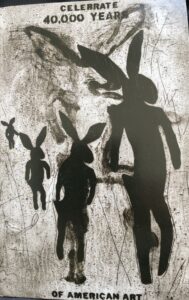
The first work we see inside the exhibition is 40,000 years of American painting that reminds us how short is the time of colonialism, the English language in North Americam as well as the art conventions brought in from Europe and called American after a Spanish explorer.
The stupendous paintings layer many realities. In addition to canoes, her major framing images are maps, clothing, horses, buffaloes, animals and figures.
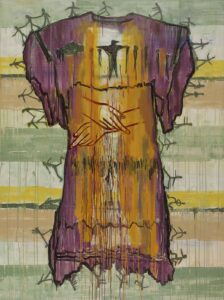
But in each case the image is filled with many references to myths and history: Who Leads Who Follows for example has the overall motif of a traditional dress, marching around the entire edge of the dress are stick figures,On the chest area is a raven/human and not far away is a buffalo. two outlined hands fold across the abdomen. Many signfiers , and what does it say?
We can read fragmentation and survival.
The theme of the Native American survival in spite of so many efforts to obliterate them is at the core of both Harjo’s poetry and Jaune’s painting,.
To elaborate on Jaune’s exhibition:
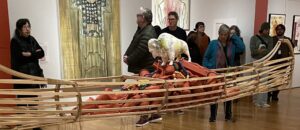 Trade canoes are a major theme. In this exhibition we have eight, two actually built of pinewood lath with her son Neal Ambrose-Smith. On one we see a carved white buffalo. The white buffalo has great significance to Lakota and Plains Indians. On June 4, 2024, a white buffalo calf was born in Yellowstone National Park Lakota Sioux chief Arvol Looking Horse said in an interview “The birth of this calf is both a blessing and warning. We must do more,”
Trade canoes are a major theme. In this exhibition we have eight, two actually built of pinewood lath with her son Neal Ambrose-Smith. On one we see a carved white buffalo. The white buffalo has great significance to Lakota and Plains Indians. On June 4, 2024, a white buffalo calf was born in Yellowstone National Park Lakota Sioux chief Arvol Looking Horse said in an interview “The birth of this calf is both a blessing and warning. We must do more,”
As an object in itself a canoe can simply refer to a means of transportation and community connection. The cultural significance and challenges of canoe journeys are now familiar to us. Revived in 1989, this year hundreds of canoes from all over the Northwest came to Alki Beach where the Denny party landed in 1851 greeted by Chief Seattle.
The artist states:
“Remember when the trade canoes came up river, they would be piled with bags of moldy flour, wormy beef, whiskey laced with lead and blankets smeared with smallpox” (p. 21 Memory Map, interview with Lowery Stokes Sims
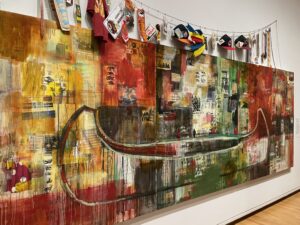
Jaune Quick-to-See Smith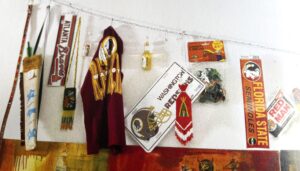 began depicting canoes at the time of the 1992 celebration of Columbus’ arrival in 1492. Needless to say, the arrival of Columbus was no cause for celebration among Indigenous peoples. So this first canoe called Trade Gifts for Trading Lands with White People is full of amusing details, such as the “gifts” strung across the top of the painting are Indian themed kitsch. The canoe is empty unlike her subsequent canoes.
began depicting canoes at the time of the 1992 celebration of Columbus’ arrival in 1492. Needless to say, the arrival of Columbus was no cause for celebration among Indigenous peoples. So this first canoe called Trade Gifts for Trading Lands with White People is full of amusing details, such as the “gifts” strung across the top of the painting are Indian themed kitsch. The canoe is empty unlike her subsequent canoes.
The trade canoes in the exhibition are full to capacity with people, animals, trees, and imaginary creatures. They are often surrounded by a sea of collage that speaks to the abuses and contradictions of native life. But one of Smith’s amazing talents is taking the dreadful and making it amusing even as we don’t lose sight of the horrors. I think this is called Indian humor.
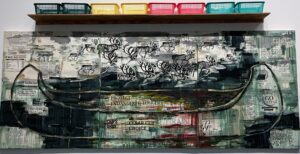
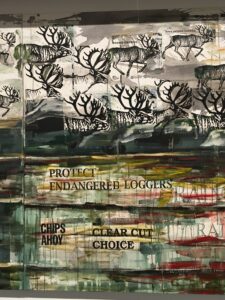
Tongass Trade Canoe 1996, a blockbuster painting, refers to the attempt to bring oil drilling to the fragile Tongass National Forest, the calving land of the Caribou, whom we see galloping across the top of the painting. Above are real laundry baskets suggesting a commodity that comes from oil drilling. The Tongass, after a decade of fighting, was finally protected in 2023 from development (we hope).
Smith’s takes on famous white artists and, in my opinion, outdoes them by adding much more meaning. The maps in the exhibition were initially inspired by Jasper Johns but look where the artist goes with them.
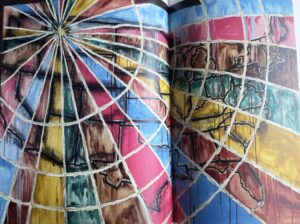
In Homeland, the focal point of the radiating lines is Montana in the upper left where the artist was born. There is a US map underneath, but the radiating lines and colors create an entirely new dynamic. Smith dismisses the traditional lines of US maps, the states, as arbitrarily cutting across Indian lands and tribes.
Other repeated icons in her work, horses and buffalo and food and General Custer in deep trouble.
What the artist cares most about is the land and the deep connection of all Indigenous people to their land in spite of the ravages of the White greed for oil, gas, and other sources of “energy’.
In 2023 she curated a major exhibition at the National Gallery called: The Land Carries Our Ancestors, Contemporary Art by Native Americans that demonstrated that this theme pervades contemporary native art. It included fifty Native artists and essays like “Sky as Place, Land as Body, Landscape as Spiritual Compass,” by heather ahtone and “Land/Landbase/Landscape” by Smith. Creating this exhibition simultaneously with her own retrospective speaks to her deep connection to her community.
“Memory Map” is an outstanding exhibition by one of the most creative thinkers working today.
Jo Harjo’s poetry gives us a day to day reminder of her brilliance:
You can buy the book or listen to a poem a day. Here is a description of the book.”A stunning new volume from the first Native American Poet Laureate of the United States, informed by her tribal history and connection to the land.”
What’s so wonderful is that her poetry is so understandable. And Jaune’s painting is accessible to all of us.
This entry was posted on August 7, 2024 and is filed under Uncategorized.


